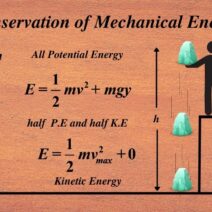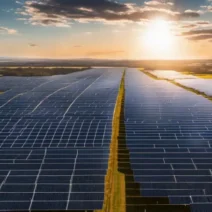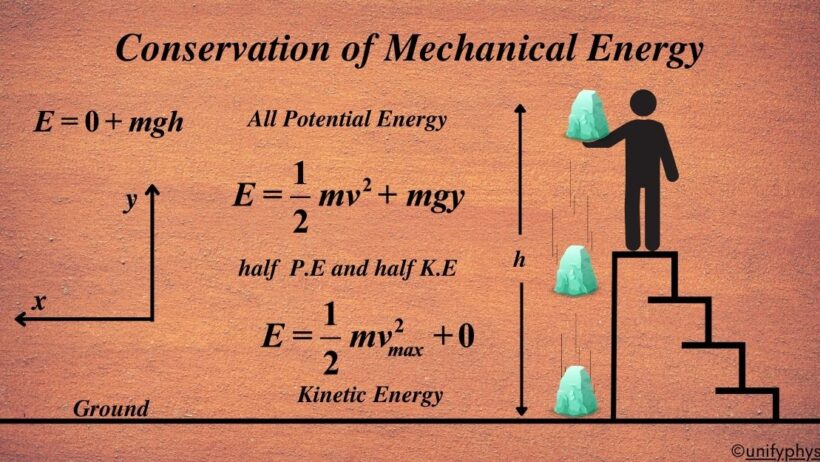Mechanical energy conservation is a fundamental principle in physics that describes the transformation and transfer of energy within various systems. This concept is rooted in the Law of Conservation of Energy, which asserts that energy cannot be created or destroyed, only converted from one form to another. The focus on mechanical energy is particularly pertinent in dynamic systems where kinetic and potential energies interplay. Understanding this principle not only elucidates various natural phenomena but also lays the groundwork for numerous technological advancements and environmental considerations.
The essence of mechanical energy can be categorized into two primary forms: kinetic energy and potential energy. Kinetic energy is the energy an object possesses due to its motion. This energy is mathematically expressed as KE = 1/2 mv², where m represents the mass of the object and v denotes its velocity. Conversely, potential energy is stored energy based on an object’s position or configuration, typically gravitational potential energy. This is calculated with the formula PE = mgh, wherein g represents the acceleration due to gravity and h indicates the height above a reference point.
When examining a closed system devoid of non-conservative forces such as friction or air resistance, the total mechanical energy remains constant. This conservation implies that any loss in potential energy will be matched by an equal gain in kinetic energy, allowing an object to convert energy back and forth without loss, barring outside forces. A classic illustration of this phenomenon is a simple pendulum. At the peak of its swing, the pendulum has maximum potential energy and minimal kinetic energy. As it descends, the potential energy is converted into kinetic energy, reaching maximum kinetic energy at the lowest point of the swing. This seamless transformation epitomizes the principle of energy conservation.
On a broader scale, mechanical energy conservation unfolds across numerous domains, promising practical applications and addressing environmental concerns. For instance, in the realm of transportation, cars, trains, and aeroplanes rely on principles of mechanical energy to function efficiently. By optimizing energy conservation practices, engineers can reduce fuel consumption and mitigate emissions, thus contributing positively to environmental sustainability.
Renewable energy technologies also draw upon the tenets of mechanical energy conservation. Wind turbines, for example, convert kinetic energy from wind into mechanical energy, subsequently transforming it into electrical energy. The efficient harnessing of kinetic energy for power generation illustrates a profound understanding of mechanical energy conservation and its potential to create a greener future.
Another area where mechanical energy conservation is pertinent is in the study of harmonics and vibrations. In many engineering applications, managing vibrational energy is crucial. Mechanical systems often exhibit vibration modes that can be detrimental if not properly accounted for. By applying the concept of mechanical energy conservation, engineers can devise solutions to mitigate these vibrations, thus enhancing the longevity and performance of machinery.
The conservation of mechanical energy also engenders a profound sense of fascination, spurring curiosity about the underlying mechanics of everyday occurrences. For instance, consider a rollercoaster. As a rollercoaster climbs to the peak of a track, it accumulates potential energy. As it plunges downward, the dramatic descent not only captivates thrill-seekers but also vividly exemplifies kinetic energy’s dominance at play. This dynamic interplay offers insights into larger principles governing motion and energy transfer, revealing a deeper appreciation for the natural laws governing our world.
Yet, while the conservation of mechanical energy is an elegant principle, challenges arise in real-world applications. Friction, air resistance, and other non-conservative forces can dissipate energy as heat, resulting in losses that deviate from the ideal conditions described by mechanical energy conservation. This discrepancy necessitates the continual refinement of materials and designs to minimize energy losses, underscoring the need for innovation in energy-efficient technologies.
In sum, mechanical energy conservation represents a pivotal concept in physics, illustrating how energy transitions between kinetic and potential states without loss in a closed system. The implications of this principle extend beyond academic study, informing practical applications in transportation, renewable energy, and engineering practices, while nurturing a profound appreciation for the forces at play in our environment. As we innovate and strive for sustainability, a comprehensive understanding of mechanical energy can pave the way for advancements that not only harness energy more effectively but also respect and preserve our planet’s resources.
In essence, the exploration of mechanical energy conservation offers not only a glimpse into the mechanics of nature but also a clarion call for responsible energy practices. Whether one is delighting in the thrill of a rollercoaster or observing the graceful arc of a swinging pendulum, the underlying principles remind us that energy is not merely a concept to be studied; it is an omnipresent force to be respected and understood. The implications of this knowledge are profound, leading to innovations and practices that hold the potential to shape our future sustainably.






